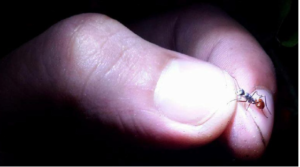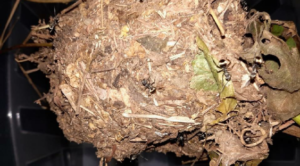There are over 600 species of Polyrhachis and about 100 different species can be found in the Philippines.
Despite being one of the more common ant species where it is endemic, it has not been completely described as a species owing to the many subspecies under it and their diversity.
The diversity of the Polyrhachis species is, perhaps, another reason for their appeal; Wikipedia lists the aforementioned nest weavers (such as Polyrhachis dives). There are also swimming ant workers (such as Polyrhachis sokolova), and the species inhabits both soil (Polyrhachis proxima) and trees (Polyrhachis bicolor).

Physical Appearance
Polyrhachis ants are medium-sized ants (workers range in size from 5-10 millimeters in length). Queen ants are generally larger than the rest of the colony and have wings present during their nuptial flights, but when a queen has chosen a place to establish her colony, she sheds her wings, leaving behind only wing scars on her back. These ants come in different colors, depending on the species. They are generally shiny as well.
While their eyes are developed, worker ants often have no ocelli or simple eyes. There are 12 segments to their antennae. Polyrhachis sp. has no stinger, but they have spines on their bodies that differ in location depending on the species. Since the Polyrhachis sp. is a very diverse genus, the appearance of the spines greatly varies in size and shape. Polyrhachis sp. eggs are oval in shape. The larval stage of the Polyrhachis sp. produces silk for nest construction and the same kind of silk is used when the larva turns to a pupa and eventually becomes full grown ants.
Where are The Found?
Aside from the Philippines, Polyrhachis ant species can be found in the Old World (Africa, Asia, Europe, and Australia) tropics.
These ants usually prefer places with higher elevation. The different species of Polyrhachis ants prefer different kinds of trees to establish their colonies, though some species also prefer to build a colony in the ground rather than on trees. The Australian Polyrhachis sp. is also known to swim as it thrives near inter tidal mud flats. Generally, Polyrhachis sp. usually nests on trees but collect food from the ground; however, they can also establish their colony in the ground if needed. This adaptability enables them to live longer and avoid extinction.

Polyrhachis sp. as Pets: Talking with an Ant Keeper
These ants, while not easy to find, have been gaining in popularity recently in the ant keeping hobby because of their well-built nests in the wild, which are held together by silk produced by the larval stage of these ants.
Ant keeper Naethan Alonzo shared his experiences in keeping these creatures in captivity. Alonzo uses a setup with live plants inside a terrarium; the ants’ nest was hung on one of the branches of the young tree in the setup.
Do they make good pets?
“The Polyrhachis sp. makes…great [pets] because they look good in terrariums with good setups. Their size is easy to appreciate; [because they are fairly large, they are] very visible in the terrarium. These… ants are very active and keep wandering around the enclosure as the workers look for food to hoard.

What are the eating and hunting habits of the Polyrhachis sp. in captivity?
Alonzo says that in his experience, “…the Polyrhachis sp. eats a variety of insects and [I] sometimes [give them] fruits as treats. They suck the juice of the fruit and obtain fluids from it as well. They also love [a] sugar and water solution. The terrarium is also misted regularly for [the benefit of] the live plant inside the setup.”
Does he recommend that ant fanciers—particularly beginners—keep Polyrhachis sp.? Are they easy to maintain?
“Yes, if one is able to find a fertile queen during a nuptial flight sometime around February. The colony is fairly easy to maintain because they only eat insects and fruits. It is easier to maintain than ants put in a molded formicarium. Aspiring Polyrhachis sp. keepers need to provide a large terrarium for this colony to be able to observe their behavior more naturally.”
In his opinion, what makes Polyrhachis sp. unique?
“They have a habit of carrying the dead members of their colonies out of their nests, as if they have nowhere to put these dead bodies. They want to keep [the corpses] as far away from the nest as possible. Sometimes, the Polyrhachis sp. [attack] their own [drones] (fertile male ants) when [these hatch] too far from the nuptial flight season, because it will not be of any use [to] the colony during that time and will [have to be allotted a share of the colony’s food supply].

Benefits of Polyrhachis sp. extract to humans?
A Google search will turn up something interesting: there are many sites offering Polyrhachis extract for sale. More interestingly, you’ll also find papers from authoritative sources such as the NCBI or National Center for Biotechnology Information discussing results of laboratory tests using ant polyrhachis vicina roger.
Research would suggest that extract from the Polyrhachis species has various positive effects on the human body due to the nutrients it is comprised of. Said to be easily absorbed by the human body, Polyrhachis ant extract has been used in China for over 3,000 years. Among the nutrients it has been discovered to contain in significant amounts are protein, the vitamins B1, B2, B12, D, and E, and the minerals calcium, phosphorus, iron, manganese, selenium, zinc and other trace elements. Popular attributions to Polyrhachis extract are anti-inflammatory properties, anti-aging properties, and even aphrodisiac qualities. More studies on its benefits are currently ongoing.
Taxonomic Classification
Kingdom: Animalia
Phylum: Arthropoda
Class: Insecta
Order: Hymenoptera
Superfamily: Vespoidea
Family: Formicidae
Genus: Polyrhachis
Did you know:
• The Polyrhachis ant can lift up to 400 times its body weight and drag items up to 1,000 times its body weight?
• The Polyrhachis sp.is one of the longest living insects and can survive for up to 30 years.
• In previous centuries, Polyrachis ant extract was only served to emperors and nobles.
• Polyrhachis is the most diverse ant group (genera) in the world.
This appeared in Animal Scene’s February 2016 issue.






